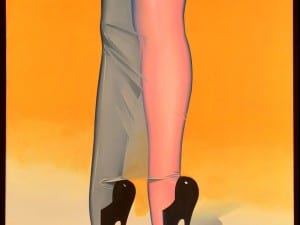The highly anticipated Light Show has opened to the public at the Hayward Gallery running until 28 April. The exhibition sees some of the finest works of light art illuminate the Hayward in a fantastically exuberant manner. The chosen art spans across the 20th century, ranging from well-established names like Dan Flavin to comparatively undiscovered gems such as Carlos Cruz-Diez. But there is more to the Light Show than just an offering of colourful lights. It is easy to see in the early 20th century, from the use of naked bulbs, a rise in the incorporation of neon, while the latter half of the century is immersed in commerical driven concerns, most evident in Pop Art.
A contemporary take on this wild infusion is David Batchelor’s Magic Hour (2004 – 2007) which uses found industrial objects constructed on to each other. This is combined with garish coloured lights set against a wall encompassing the sculptural structure in an effervescent halo, which seems to be an intriguing synthesis of cold wrought material and advertising culture. Yet, as one proceeds through the gallery, distinguishing the effects and manipulations of light the ambiences created around the audiences’ participation becomes key to reading of the work. For example, Doug Wheeler’s Untitled (1969) sees the viewers having to place plastic bags over their shoes and enter a clinical snow storm, so disorientating that it becomes a powerful hypnotic drug. At the centre of the room is a blue neon light frame with a frosted white pane in the middle. When viewed in a solitary manner the light coldly seeps across the white floor, walls and ceiling, distilling a chilling atmosphere of suspended life – almost a purgatory mood. However, when crowded with spectators and the dull roar of analytical dialogue echoes, the space becomes a surreal and dense mixture of hot and cold as the blue haze loses its prowess, becoming docile.
On the second floor Dan Flavin’s The Nominal Three (To William Of Okham) (1963) shows a series of white neon lights in an ascending amount of one to three with the exact same space between them. The work stands unobtrusively in an alcove filled with minimal and conceptual discourse waiting to be explored. This is strongly contrasted by what follows in the room opposite, where Jenny Holzer’s MONUMENT (2008) is located. It is an almighty tower of flashing LED text documenting the accounts of soldiers and declassified documents. As the LED’s dance around the structure, a strong and peculiar pink fog is emitted by neon strips, reducing the seriousness and gravity of the information provided through the text – a powerful display of the desensitisation of archives of violence in society particularly media.
The manner in which artists have adapted and explored the notion of light within the context of art history is relatively small and largely experimental, even to this day. At the Hayward, however, one feels as if there are transgressing a history so thick and rich of tangent discovery that one cannot leave uninspired as to see what will be produced by the light artist of now and the future.
Light Show, Until 28 April, Hayward Gallery, Southbank Centre, Belvedere Road, London, SE1 8XX
William Davie
For an in-depth feature and an intreview with Cliff Lauson, pick up a copy of Aesthetica 51 available at www.aestheticamagazine.com/shop
Credits
1. David Batchelor, Magic Hour, 2004-7. Found steel and aluminium lightboxes, found steel supports, acrylic sheet, flourescent lights, cable and plugboards, 308 x 276 x 50 cm. Photo: David Batchelor.





